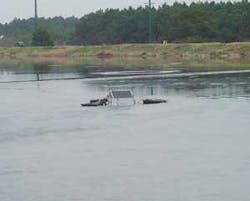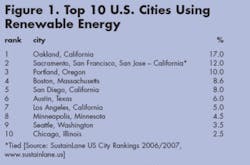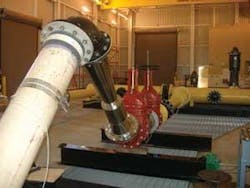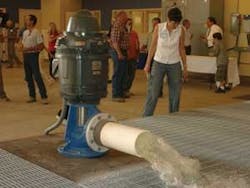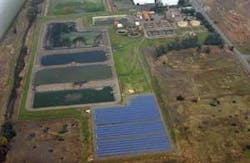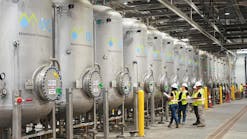By Mike Breslin
Advances in photovoltaics have made capturing the power of the sun to offset water and wastewater system energy needs more practical than ever, as evidenced in the USA as well as developing nations.
520 kW array at Sewerage Commission-Oroville Region (SCOR) in California is the largest dual-tilt photovoltaic system in the world and provides enough electricity to treat 80% of 1.2 billion gallons of wastewater annually. [Photo courtesy of SPG Solar]
David Zoldoske is more than a believer in renewable energy, particularly solar power.
“Solar power and water pumping seem destined for each other and will play a larger role here in the U.S. and internationally for drinking water, water treatment, irrigation and industrial plants. The problem of converting DC photovoltaic energy directly to AC standard motors has been largely overcome by technology and today we can power pumps up to 1,000 hp range without reliance on a traditional grid,” said the director of the California State University-Fresno’s International Center for Water Technology (ICWT) in Fresno, California, USA.
California Dreaming
It should be pointed out, six California cities rank in the top 10 U.S. municipalities making use of renewable energy resources (see Figure 1).
“In our hydraulic laboratory,” said Zoldoske, “we have a 50-hp demonstration pump that runs on solar and, when not in use, we feed electricity back into the grid and earn net metering credits. We have also proposed a statewide solar initiative aimed at converting up to 10% of our state’s agricultural pumps to be supported by a solar array. This is our agricultural response to California’s plan to promote a million solar roofs in the residential sector.”
Every month, ICWT gets visitors from around the world, be that China, India, Australia, Japan or Israel, to view innovations being developed there. Water shortages are a huge issue globally and most visitors are interested in how to use water more efficiently. But, secondarily, since water needs to be pumped, there’s an energy component to consider. And, as worldwide energy prices rise and concerns over carbon emissions intensify, obviously solar is a leading clean alternative – if the investment can be justified.
Zoldoske stresses: “We’ve been looking at solar water-pumping for over 20 years and one of the natural things about straight solar water pumping is you can design an irrigation system to take advantage of the sun’s travel path on a daily basis because it nearly matches the evapo-transpiration rate of plants. As it gets hotter, as days get longer, plants need more water; but, because you have more intense sunlight, you can also pump more water. There’s a very synergistic relationship between solar water pumping and plant water demand.”
Subsidized Motivation
The motivation for using solar for water applications is fighting the relentless battle against rising energy costs and pollution, particularly relying on solar electricity during the middle of day when peak utility rates are highest. A milestone in the trend was reached in 2001 when northern California’s Sewage Commission-Oroville Region (SCOR) received a 41% utility rate increase. “To keep our rate low for our ratepayers, we looked into alternative forms of energy and we settled on solar,” said Bill Lampkin SCOR’s environmental compliance manager. By May 2002, SCOR broke ground on a 520-kW solar system, designed and built by SPG Solar. By October, it was powering its wastewater treatment plant. SCOR, which serves over 15,000 families and businesses – becoming the first predominately solar U.S. wastewater treatment plant and reducing its annual electric bill by 51%.
More significantly, when others saw how well SCOR’s system worked and how much money it saved, they jumped on the solar bandwagon. The Butte County government followed by the Butte County Community College each built bigger 1-mW photovoltaic systems. Also inspired by SCOR were the Sonoma County Water Agency’s 596-kW solar system and South Feather Water & Power’s 566-kW system. These installations were all supported by public policy rebate programs covering about half the installation costs – the public benefit being reduced carbon emissions and more widely distributed power generation.
Most of the new California solar installations pay their way by feeding electricity back to the grid to earn net metering credits – but, when the grid goes down, they must resort to backup power such as diesel generators that are expensive and dirty to run. In San Diego County, Valley Center Municipal Water District is taking solar water pumping by breaking ground on a 1.2-mW solar system that incorporates advanced motor control technology which seamlessly blends solar and grid electricity, but also allows operation of several 350-hp pumps while off the grid. Sustaining operations during grid failures is becoming a high priority in an earthquake and fire prone state.
50 hp test pump at International Center for Water Technology (ICWT) in Fresno, California, is powered by rooftop solar array. ICWT was established in 2001 to educate, promote and assist in the development of innovative technologies that improve water utilization, reduce energy demand and positively impact air quality
Without subsidies, rebates and renewable energy credits, many U.S. solar-water projects are currently difficult to justify on a traditional return-on-investment timetable compared to grid pricing. But, as energy prices rise and as newer solar technologies reach the marketplace, those numbers may tell a different story.
Developing Models
The Philippines – On the Philippine island of Cebu in the remote off-grid town of Ronda, a municipal solar-water pumping system is financing itself. Before the system was operational, drinking water had to be trucked into this mountainous region and was unreliable. Now, residents buy an AquaCard, a debit card similar to a prepaid phone card, and insert it into a water dispensing unit to tap clean drinking water that’s cheaper, fresher and more convenient than trucked-in water. This first-of-its-kind system may be a model for other developing nations. It involved no special grants or subsidies, and the capital investment to build the system is recovered by water sales.
A Bright Idea
For further information on organizations discussed in this article on solar power as a renewable alternative for water & wastewater energy needs, see:
- International Center for Water Technology – www.icwt.net
- Valley Center Municipal Water District – www.vcmwd.org
- WorldWater & Solar Technologies Inc. – www.worldwater.com
- SPG Solar Inc. – www.spgsolar.com
Also see:
- v U.S. National Renewable Energy Laboratory – www.nrel.gov
- California Energy Commission-Process Efficiency – www.energy.ca.gov/process/
- San Francisco Public Utilities Commission-GoSolarSF program – www.sfwater.org
- SolarBee Inc. – www.solarbee.com
“For off-the-grid applications solar is fast becoming the fuel of choice because the technology of solar is improving, coming down in cost while the cost of diesel and gasoline fueled generators is going up,” claims Mickey Ingles, product development director for WorldWater & Solar Technologies. His company’s Mobile MaxPure solar pumping, power and water purification unit is now solving both energy and waterborne disease problems at remote locations around the world. The unit is a 7-foot cube designed to be shipped anywhere. An on-board battery bank powers automatic deployment of a 3.2-kW solar panel array and, 30 minutes later, the unit is pumping and purifying contaminated water through a built-in, three-stage filtering system. It can make up to 30,000 gallons a day (gpd) of clean drinking water – exceeding World Health Organization purity standards. It also can be configured to desalinate brackish or salt water, comes with a back-up generator and a battery bank to store power for night operations.
Iraq & Africa – Over the past few months Iraqi farmers and their families along the Euphrates River received 12 new portable Mobile MaxPure units. These farmers don’t have reliable power from the grid to operate irrigation pumps or to treat their water for drinking because the river is seriously polluted. In Nigeria and Ethiopia, other units are providing clean drinking water for off-the-grid rural populations. Another 12 units are now on route to refugee camps in the Darfur region of Sudan. Horrible camp living conditions and spread of disease are exacerbated by contaminated surface water and trucked-in water of questionable quality. “In the developing world, water quality is now recognized as critical to national economic development. With clean water you get a healthier population, reduce healthcare cost and can concentrate on education and jobs to improve an economy. There’s a direct correlation all the way along,” Ingles said.
Mobile MaxPure portable solar systems being deployed in Iraq by U.S. Military. 12 units made by WorldWater & Solar Technologies were donated by the Morrell Foundation
Most promising are new, more cost-efficient cells entering the market that may be game-changers – concentrator photovoltaics (CVP), multi-junction cells and thin-films that may make solar economically competitive with traditional forms of energy, without subsidies. A recent surge of interest in green technologies due to the oil crisis means there’s no telling how big solar for water applications will become.
Author’s Note:
Mike Breslin is a freelance writer specializing in engineering and technology. He’s also author of the sea adventure novels Found At Sea, Mystery of the Fjord Tide and Riddle of the Atlantis Moon.
